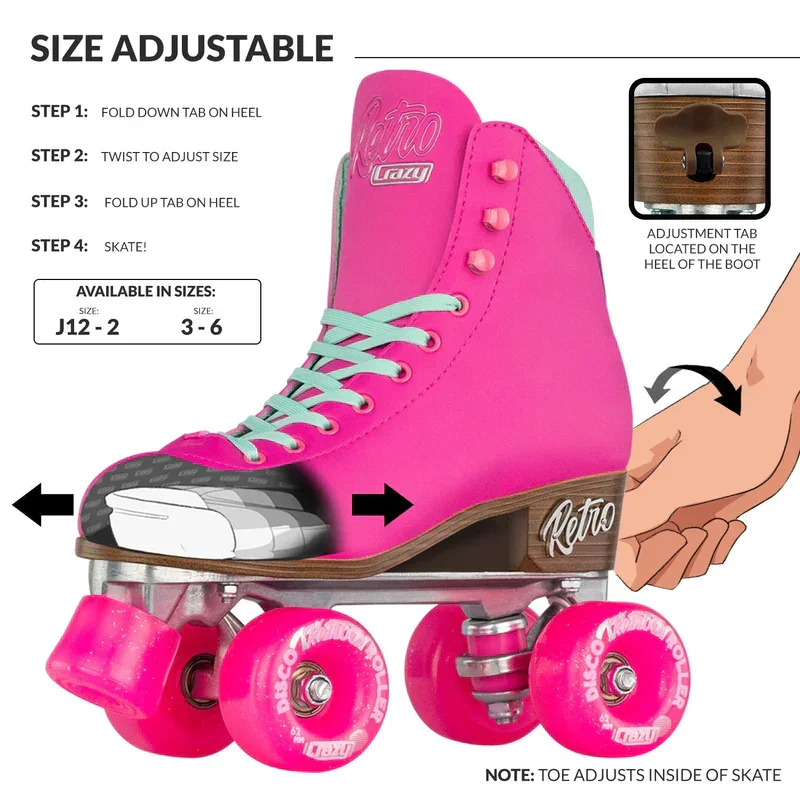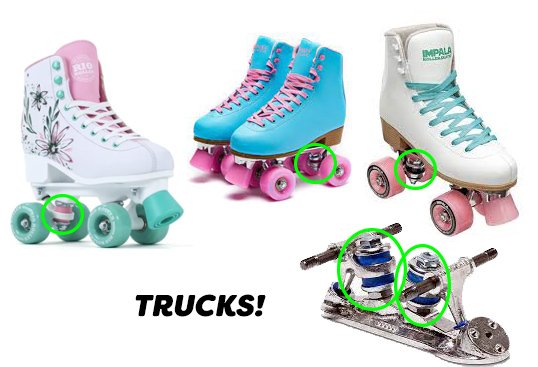A guide to buying first pair of roller skates for your child
Purchasing your child’s first pair of roller skates can feel overwhelming—especially with so many brands, sizes, and features to choose from. This guide is designed to help you confidently choose the right skates, so your little one can have a safe and joyful skating experience.
👣 Why Size Matters
Don’t go too big! A common (but misguided) approach is to buy the largest size so the child can grow into them. When the skates are too big, the feet moves around inside the boot. This often results in blisters, poor control, and frustration.
Best fit: Aim for skates that are no more than one size up from your child’s actual shoe size. If there’s extra room inside, add padding (like cotton wool) to prevent unwanted movement.
🛼 Adjustable Skates:
Pros & Cons
Toe-Extension Skates
Example of toe-extension skates
These skates adjust by pulling the toe part of the boot outward, making the entire boot longer. You’ll often see a button or clip on the side that releases the toe section.
Pros: Simple to use and often more affordable.
Cons: As the boot gets longer, the wheels may end up positioned poorly — too far forward or backward from the natural pressure points of the foot (especially the ball), which can affect balance and control.
Illustration of how the ball of the feet should align with the front wheels.
Internal Twist-Adjustment Skates
These use a twist mechanism (usually at the heel or arch) that adjusts the inner boot size by shifting the internal footbed forward or backward.
Pros: Keeps the wheelbase in a more stable, fixed position and offers a snugger fit as your child grows.
Cons: Heavier and longer than needed, may look like clown shoes
Example of a internal twist-adjustment roller skates
Teach Your Child How To Skate 🛼 - even if you’re not a skater
This comprehensive guide is designed for parents and carers who want to confidently teach their child how to roller skate—even if you’ve never skated before! Empower yourself with the knowledge, techniques, and tips to make skating a fun and safe experience for both you and your child.
🚫 Trucks: What They Do & When They Matter
What are trucks? These pivot mechanisms under the boot allow wheels to turn when a skater shifts weight from side to side. They make turning smooth and responsive.
Why cheap budget skates may struggle: Some low-end models (even from known retailers) have overly stiff or non-functional trucks, meaning skaters must lift and reposition their feet manually to turn—harder for inexperienced skaters.
Ideal quality: Choose skates with soft, compressible cushions (bushings) for smoother turning and easier handling—especially for lighter children.
Roller skates with trucks
Roller skates without trucks
Roller skates from Kmart and Rebel Sports have very stiff trucks
👶 Children 5 & Under
At this early stage, young kids and toddlers are still developing balance and coordination. Traditional trucks are often unnecessary—or even a hindrance.
Better option: Lighter, wide-base skates without trucks or with wheel-locking features allow children to get used to the weight and feel of the skate before actual rolling begins.
Crazy Skates Trolls from J11
Starfire 500 from j13
Epic Princess from j10
Most roller skates start from size 1. Only a few brands make good smaller sizes:
Epic Princess (from j10)
Crazy Skates Rocket (from j10)
Starfire 500 (from j13)
Trolls Klip Klop (adjustable j11-1)
Crazy Skates Prime (adjustable j9-j12)
⚙️ Toe Stops: Rubber/urethane Over Plastic
Plastic toe stops
Preferred material: Rubber/urethane toe stops grip better, absorb pressure more gently, and are safer for indoor surfaces. Also non-marking
Avoid hard plastic stops—they can scratch flooring and feel clunky when stopping.
Look at this skate’s toe stop
I once came across a pair of skates with an unusual toe stop material. When I tapped on it with my fingernail, it made a distinct clinking noise—definitely not rubber!
✅ Recap: Best Skate Features by Age & Stage
|
Age Group |
Recommended Skate Type |
Key Features |
|---|---|---|
|
5 years and under |
Lightweight, wide-base skates
|
Optional wheel-lock, no trucks is ok |
|
Around 6–7 |
Fixed size boots with flexible trucks |
Good fit, not over-size, soft cushions |
|
Older or growing beginner |
Adjustable skates (short-term use) |
Be cautious of weight, length and wheel alignment |
|
Serious learners/adults |
Fixed-size skates
|
High-quality boots and trucks, proper fit |
An 18 month old on lightweight roller skates with wheel-lock function.
.
💡 Final Tips
Don’t let size upstop your child’s learning: choose skates that actually fit and match their current ability.
As they grow in confidence (especially around age 6+), look for skates with soft, responsive trucks that let them turn naturally.
Rubber toe stops, and proper fit matter just as much as style.
And above all—prioritise safety, stability, and fun in their first skating experience.
Ready to get your roller skates?
Head to the skate shop right here!
Teach Your Child How To Skate 🛼 - even if you’re not a skater
This comprehensive guide is designed for parents and carers who want to confidently teach their child how to roller skate—even if you’ve never skated before! Empower yourself with the knowledge, techniques, and tips to make skating a fun and safe experience for both you and your child.
















